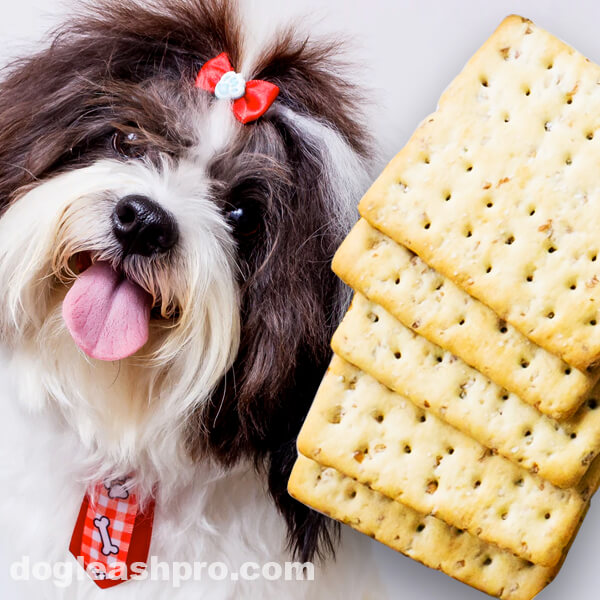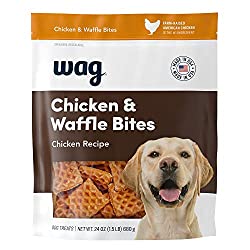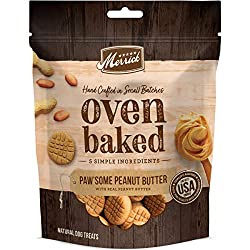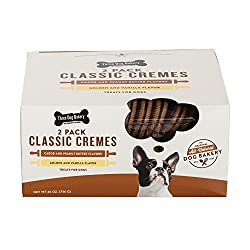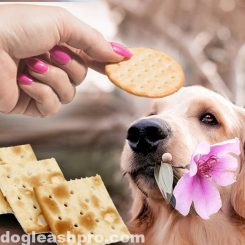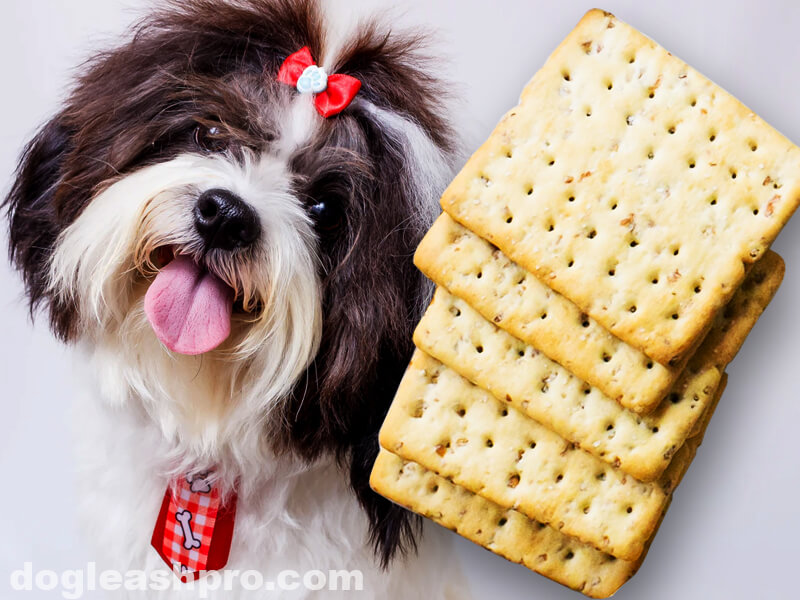
You’re probably enjoying some Saltine Crackers right now either by themselves or with Peanut Butter and jelly, guacamole, or salsa. As you sit there crunching on these salty crackers, your dogs are probably begging for some or giving you the puppy eyes. You’re about to hand them one but hesitated because you’re wondering if Saltine Crackers are safe for doggy consumption.
Can dogs eat Saltine Crackers? No, dogs should not eat Saltine Crackers because it is high in salt, sugar, and carbohydrates. These three combinations can lead to health issues like weight gain, upset stomach, and in severe cases salt poisoning in dogs. If you must, moderation is key. You can occasionally give your dogs one Saltine Cracker.
Table of Contents
Can dogs have Saltine Crackers?
Dogs should not have Saltine Crackers. Saltine Crackers are basically soda crackers and they can contain soy products or wheat products with very high salt content (you can find the exact amount of sodium used in several different Saltine Crackers brands near the middle of the page).
There are tons of canine-friendly dog treats that are wheat and soy-free like these ones here. Our dogs love these:
To truly understand why dogs should not have Saltine Crackers, let’s take a look at what Saltine Crackers are and the ingredients used in two of the most popular brands of Saltine Crackers, Premium Saltine Cracker and Zesta Saltine Crackers.
What are Saltine Crackers?
If you’re wondering what are saltines, they are very salty thin crackers that are shaped like a square. Saltine Crackers make for a great snack and have a crisp dry texture. Sometimes, the Saltine Crackers are sold in perforated sheets of two. The perforated edges allow you to easily break off one Saltine Cracker without damaging the other one.
There are many ways to eat them. One can eat them individually or crush them and sprinkle them on soups or on mac and cheese dishes. Some choose to add peanut butter, cheese, or creamy Hummus to them. Others use them to make s’mores while camping.
You’ll notice about 13 tiny holes in the Saltine Crackers. These docker holes were punched in before baking to allow the steam to escape during the baking process. This keeps the Saltine Crackers flat and prevents them from rising.
Sometimes, Saltine Crackers are referred to as soda crackers because these crackers are made with leavening agents such as baking soda.
What are Saltine Crackers made of?
As the name of the cracker suggests, this type of cracker is very salty. The Saltine Crackers are made up of four main ingredients: white flour, baking soda, yeast, and coarse salt.
If your pups love cookies, we highly recommend this as well:
Saltine Crackers ingredients
Now, let’s take a deeper look at the ingredients in Saltine Crackers, specifically two of the most popular Saltine Crackers brands, Premium Saltine Cracker and Zesta Saltine Crackers, and see why Saltine Crackers are not safe or healthy for our canine companions.
Nabisco Saltine Crackers ingredients
The Nabisco Saltine Crackers are also known as Premium Saltine Crackers. These Saltine Crackers contain the following ingredients:
- Unbleached enriched flour includes wheat flour, niacin, reduced iron, thiamine mononitrate (Vitamin B1) riboflavin (Vitamin B2), and folic acid.
- Soybean oil.
- Partially hydrogenated cottonseed oil.
- Sea salt.
- Salt.
- Malted barley flour.
- Baking soda.
- Yeast.
Zesta Saltines ingredients
- Enriched flour includes wheat flour, niacin, reduced iron, Vitamin B1 (thiamin mononitrate), Vitamin B2 (riboflavin), and folic acid.
- Soybean oil with TBHQ for freshness.
- Salt.
The Zesta Saltine Crackers also contains 2% or less of the following ingredients:
- Corn syrup.
- Baking soda.
- Yeast.
- Soy lecithin.
As you can see, both popular brands of Saltine Crackers share many of the same ingredients. Some of these ingredients are hard to pronounce and it is said that if you can’t pronounce a certain ingredient on the food packaging or you don’t know what it is, it’s probably best to skip that food.
This reasoning stands true when it comes to our furry friend’s diet. Let’s go through the ingredients individually so you can see why.
Enriched flour is harmful to dogs with wheat allergies
The enriched flour is from wheat flour, which is one of the main ingredients of Saltine Crackers. If your furry pooch is allergic to wheat, please avoid giving them Saltine Crackers.
You’ll know that your pups have a wheat allergy if they react after eating food that contains wheat. If you’re not sure whether your furry friends have a wheat allergy, there are two things you could do.
The first is to bring them to the vet for a checkup. The vet will perform a series of tests to find out if your canine friends have a wheat allergy or other types of allergies.
Alternatively, you can feed your furry friends just a tiny bit of the wheat product and see if they react. If they do react with the following symptoms, then they may have wheat allergies:
- Licking their paws frequently leading to inflamed or red paw pads.
- Itchy skin that is dry and flaky.
- Hair falling off the skin fairly quickly causing bald spots.
- Easily sunburn due to the bald spots.
- Upset stomach.
- Gastrointestinal upset.
Be sure to consult with your vet if you’re seeing the above symptoms in your furry family members. This will confirm that they are allergic to wheat. Upon proper diagnosis from your vet that your pooch is allergic to wheat, it’s best to avoid feeding them food that contains wheat and that includes Saltine Crackers.
Instead of using wheat flour, try using Amaranth flour since it is gluten-free and packed full of protein, important minerals, and all the essential amino acids.
Generally, flour is not required in a dog’s diet. In both Saltine Crackers brands, enriched flour is used. This highly processed flour starts as a wheat grain and then gets processed into flour. During this flour processing, it loses many of its natural nutrients.
As the name suggests, the manufacturer then enriches the flour in order to restore the original nutrients it lost, including niacin (Vitamin B3), iron, thiamine mononitrate (Vitamin B1) riboflavin (Vitamin B2), and folic acid (Vitamin B9).
These B vitamins and iron are helpful to our dog’s health, but we highly recommend that our canine friends receive these vitamins and iron from their main meal or regular dog food.
The Saltine Crackers have more harmful ingredients than healthy ones and they also have a high-fat content so it is best to keep them away from our four-legged friends.
Soybean oil with TBHQ is unsafe for our furry friends
Soybean oil is a no-no for dogs that are allergic to soy or are sensitive to food with soy products. Again, if you are not sure whether your canine family member has a soy allergy, do not hesitate to bring your pooch to the vet for a checkup or contact your vet to confirm. It’s best to know in advance so your pooch can avoid any negative reactions from soy.
Since Saltine Crackers contain soybean oil, do not feed them to your furry friends with soy allergies.
Additionally, when it comes to oil, soybean oil isn’t the best type of oil for our four-legged pooch. We recommend sticking to one of the following types of oil for our pups:
- Olive oil.
- Coconut oil.
- Sunflower oil.
- Fish oil.
- Flaxseed oil.
These oils contain good fat while soybean oil contains more saturated fat.
You’re also probably wondering what TBHQ is. TBHQ is short for tertiary butylhydroquinone, which is a harmful preservative that is horrible for our dogs. If you don’t know what certain ingredients are in the food or can’t pronounce it, we highly advise that you avoid feeding that food to your pooch.
The TBHQ is used to keep the sunflower oil and Saltine Crackers fresh. It serves no nutritional value to our pooch. Instead, it harms our furry friends’ health by causing cancer in their stomachs and damaging their DNA.
I was frightened when I found out about this and this was enough reason for me to completely avoid feeding my two pups any more Saltine Crackers.
Too much Salt can lead to salt poisoning in dogs
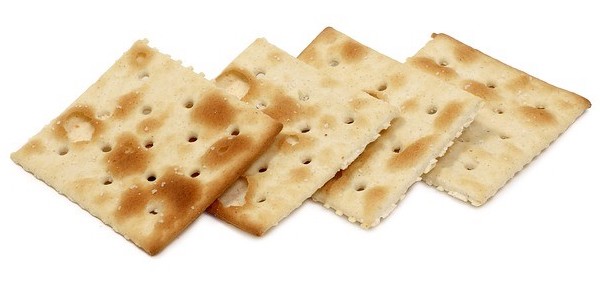
In one Nabisco Saltine Cracker, there is 27 mg of sodium. One Zesta Saltine Cracker contains 40 mg of sodium. This is considered a lot of salt for our dogs. Our furry family members generally do not need that much salt in their daily diet.
In fact, they should only have around 0.25 grams to 1.5 grams of salt for every 100 grams of food. Just 40 mg of sodium from one Zesta Saltine Cracker would already fill 0.04 grams of your pup’s daily salt requirement from a snack that is unhealthy for her. This equates to fulfilling exactly 16% of the lower end of the salt intake requirement.
Your dog’s main meal would already contain the necessary amount of sodium he needs for the day. By allowing your pooch to eat just one Saltine Cracker, she would go over this daily salt intake by 40 mg or 0.04 grams.
Eating too much salt can cause sodium poisoning in dogs. Signs of sodium ion poisoning include:
- Extreme thirst.
- Frequent urination.
- Seizures.
- Convulsions or muscle tremors.
- Body weakness.
- Muscle weakness.
- Vomiting.
- Diarrhea.
- Lethargy.
- Decrease hunger and loss of appetite.
- Lack of coordination.
- Confusion.
Baking soda is not good for dogs
If your dogs consume more than one Saltine Cracker, they are at risk of getting toxicity from baking soda. Ingesting too much baking soda can cause bloating, upset stomach, abdominal pain, and vomiting.
Fortunately, a small amount of baking soda should be fine since baking soda is not toxic to dogs. So if your pooch licks a little bit of baking soda from your kitchen counter or off the floor, there’s no need to freak out.
But do keep in mind that dogs do not need baking soda in their diet. If you must, please limit the amount of baking soda to as little as 5 to 11 teaspoons per pound of your dog’s body weight.
Yeast is toxic to dogs
Yeast from Saltine Crackers is fine for dogs but it’s very important for dog owners to be aware that raw yeast is extremely dangerous for our canine pups.
Accidentally eating yeast from bread dough that has been left on the counter to rise can cause serious damage in your dog’s stomach. That is because your dog’s warm stomach is the perfect temperature for the yeast to rise and continue expanding.
When this happens, it can be deadly. Your pooch will have extremely deadly bloating or Gastric Dilatation Volvulusyeast (GDV). Yeast can also cause alcohol poisoning in dogs.
Since the yeast from the Saltine Crackers is not raw, then it should be fine for our furry friends.
Soy lecithin is harmful to dogs that have soy allergies
Again, if your pooch has a soy allergy, avoid feeding them snacks or treats that contain soy products such as Saltine Crackers. Saltine Crackers contain soy lecithin, which does not provide any nutritional benefits to your pooch.
It’s important to note that dogs produce enough lecithin from their liver and do not need to get this from their food. But if you must, there are certainly tons of healthier canine-friendly foods that contain lecithin such as Sunflower seeds, eggs, cauliflower, or chicken liver.
So there is really no need to feed our canine friends Saltine Crackers.
A little bit more information about soy lecithin is that it is an ingredient that is used to increase the shelf life of Saltine Crackers. Also, if your furry pups are overweight, try not to feed them food or treats that contain lecithin.
Are Saltine Crackers good for dogs?

As you can see, Saltine Crackers are not good for dogs and can harm your dog’s health. Let’s look at the nutritional profile of both the Nabisco Saltine Crackers and Zesta Saltine Crackers.
Nabisco Saltine Crackers Nutrition Facts (1 Saltine Cracker or 3.2 grams)
| Name, Unit | Amount |
| Calories, cal | 14 |
| Total Fat, g | 0.4 |
| Sodium, mg | 27 |
| Total Carbohydrate, g | 2.4 |
| Protein, g | 0.2 |
| Calcium, mg | 1 |
| Potassium, mg | 5 |
This means one piece of Nabisco Saltine Cracker has about 14 calories, 0.3 grams of fat, and 2.4 grams of carbohydrate.
Zesta Saltine Crackers Nutrition Facts (One Saltine Cracker or 3 grams)
| Name, Unit | Amount |
| Calories, cal | 12 |
| Total Fat, g | 0.3 |
| Sodium, mg | 40 |
| Total Carbohydrate, g | 2.4 |
| Protein, g | 0.2 |
| Calcium, mg | 0 |
| Potassium, mg | 3 |
This means one piece of Zesta Saltine Cracker has about 12 calories, 0.3 grams of fat, and 2.4 grams of carbohydrate.
High amount of Carbohydrate that dogs don’t need
There’s 73% of carbohydrates from Saltine Crackers. While dogs do need carbohydrates, they do not need to get them from Saltine Crackers. Instead, their natural dog food should give them enough carbohydrates for the day.
High levels of calories are harmful to dogs
As you can see, one Nabisco Saltine Cracker contains 14 calories and one Zesta Saltine Cracker contains 12 calories. This is a lot of calories from snacks and treats alone.
Keep in mind the 90/10 rule when feeding your pooch treats or snacks. 90% of the calories should come from a healthy balanced and complete diet while only 10% should be from treats.
Also, the size of your dog breed matters. When it comes to how many calories your furry friends should have daily, it should be about 25 to 30 calories per pound of their body weight per day. Here is an example:
- A small Chihuahua dog weighing 7 pounds should only consume 175 calories a day.
- A medium Labrador dog weighing 70 pounds should only consume 1,750 calories a day.
In this case, a small dog breed only has 17.5 calories a day for treats. One Saltine cracker of 14 calories has almost reached this 10% treat limit. So if you have smaller dog breeds, be careful what you’re feeding them for snacks. Going over this 10% treat rule can cause weight gain and canine obesity over time.
Saltine Crackers substitute that’s canine-friendly, safe, and healthy
If your pooch loves crunchy food, try offering them some crunchy fruits and vegetables such as:
- Apples.
- Bell peppers.
- Celery.
- Green beans.
- Carrots.
Whenever I’m munching on Saltine Crackers, I will usually feed my two pups dog treats that are healthy, safe, and dog-friendly.
Here are two healthy dog treats to feed your furry friends instead of giving them Saltine Crackers. My dogs love these and would always do a circle dance when I’m opening the package. After eating one, they are always begging me for more!
So, can dogs eat Saltine Crackers?
We all want our furry family members to be happy and healthy. One main way is to feed them a well-balanced, wholesome, and nutritious diet every day. Doing so will help them maintain a healthy weight and keep them active.
Saltine Crackers are definitely not healthy for dogs. If you must, try to only give them one every few months. Frequent consumption of Saltine Crackers can cause canine obesity and can affect your dog’s energy and mood.
So try to keep Saltine Crackers away from your pooch because we all know our furry friends will inhale any and all food (eating very quickly) that you feed them.
DISCLAIMER: THIS WEBSITE DOES NOT PROVIDE MEDICAL ADVICE
The information, including but not limited to, text, graphics, images and other material contained on this website are for informational purposes only. No material on this site is intended to be a substitute for professional veterinary advice, diagnosis, or treatment. Always seek the advice of your veterinarian or other qualified health care provider with any questions you may have regarding dietary needs.
Resources:
https://en.wikipedia.org/wiki/Saltine_cracker
https://www.ehow.com/list_6855515_snack-foods-1930s.html

With over five years of specialized experience as an animal writer, my expertise lies in dog nutrition, health, behavior, grooming, and training. I am dedicated to delivering helpful and informative content that caters to the well-being of our furry friends. My primary goal is to empower pet owners with knowledge and ensure our canine companions thrive in health and happiness. In my free time, I love volunteering at local dog rescue centers.
